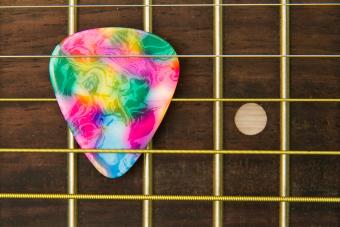
Making a list of the best acoutic guitars is an art, not a science. What makes an acoustic guitar great for one person may not work for another. As with any artistic implement, while there are standards of quality, some differences can be described only in terms of personal taste. Before you go down to the local music shop, educate yourself on what separates one acoustic guitar from another.
Brands of Best Acoustic Gutars
Just like in the world of cars, some names are just synonymous with quality. You can certainly get a quality guitar without a brand name, but some brands have built their name on a reputation of craftsmanship, service and sound. Keep in mind that top brands cost top dollars in alignment with the quality of materials and the mastery of craftsmanship.
- Gibson: The Gibson brand produces some of the world's best acoustic guitars, including the Robert Johnson L-1 and the pearl-and-silver accented Gibson SJ-250 Monarch. The latter was a favorite of such guitar heavyweights as Roy Rogers, Graham Parsons and Pete Townshend, but with a price tag of over $25,000.00, it may be out of your range.
- Epiphone: Epiphone is a junior brand of the Gibson line. The guitars are often constructed in Asia which means lower labor costs and a lower price point. However, this doesn't mean that you can't get a quality acoustic guitar at a low price. The DR-100 is excellent for beginners, and the Hummingbird is a quality instrument at a reasonable price for the intermediate guitar player.
- Fender: The Fender name is another heavyweight in the world of acoustic guitars. While you can expect a high level of craftsmanship from Fender, the price points of the high-end guitars are significantly lower than those of Gibson. The CD-60 Dreadnaught boasts low action which is perfect for the beginner.
- Martin: Martin is a name as big in the world of acoustic guitars as Marshall is in the world of tube amplifiers. The Little Martin Acoustic Guitar is a low-end guitar for the beginner, while the HD-28 is for the accomplished acoustic guitar player.
Body Types
When shopping for an acoustic guitar, you have three main body types to choose from. Which is the "best" is largely a matter of personal preferrence.
- Classic: The first type of acoustic guitar body, this body was originally designed for guitars with gut or nylon strings. They are the smallest of acoustic guitars, meaning that they provide the least amount of bass response.
- Dreadnaught: The dreadnaught body was introducted by Martin for players who wanted a greater amount of bass response from their guitar. These are the mid-sized body acoustic guitars.
- Jumbo: Gibson introduced the jumbo in an attempt to outdo Martin's dreadnaught. These guitars gained popularity after artists such as The Beatles began using them.
Wood
Another point of debate among acoustic guitar players deals with the question of what is the best type of wood to have in a guitar. Different woods create different sounds and even the same wood sounds different when placed in a different part of the guitar.
- Maple: The wood from a maple tree provides a flatter sound than most.
- Red Spruce: This wood creates a very loud volume without sacrificing a full tone, and it's considered by many guitar players to be the best wood for the top of an acoustic with steel strings.
- Indian Rosewood: For players who seek a strong bottom and darkness throughout the rest of the sound, an Indian Rosewood guitar is a good choice.
- Mahogony: The dark wood of mahogony is used by country blues players because of its punchy sound.
When picking out an acoustic guitar, remember to go with what sounds best to you. At the end of the day, that's what matters most. What other people think of the sound of a jumbo red spruce-topped guitar matters little if you think that a classic body maple best captures the sound that you want to create.







